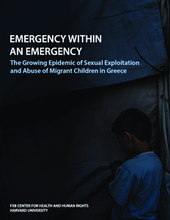Executive Summary
The present study analyzes the risk factors responsible for the exposure of migrant and refugee children to physical, psychological, and sexual violence and exploitation in Greece in the context of the ongoing migrant humanitarian crisis. It documents sexual and physical abuse of children inside migrant camps and reports new information about the commercial sexual exploitation of migrant children in the main cities of Greece. This research also explores the existing gaps and challenges in intervention efforts that contribute to victimization of migrant children.
This study was conducted using rapid assessment methodology, combining qualitative research with in situ observation. Data collection was completed in late November 2016 in four sites in Greece—namely, the islands of Lesvos and Chios and the cities of Athens and Thessaloniki. These areas were chosen because they host large migrant populations, facilities, and camps. The conclusions are based on 24 key informant and stakeholder interviews with on-site participants who work closely with migrant children and are thus qualified to comment on the conditions inside migrant facilities and camps. For ethical and security considerations, no direct interviews with migrant children or adults were conducted.
This report highlights the following six major risk factors: (1) insufficient number of specialized facilities for children; (2) risky living conditions inside camps; (3) potentially hazardous and unsupervised commingling of migrant children with the adult migrant population; (4) weak and insufficiently resourced child protection systems; (5) lack of coordination and cooperation among responsible actors; and (6) an inefficient and radically inadequate relocation scheme.
The report describes the context where migrant children are exposed to and become victims of physical, psychological, and sexual violence inside migrant facilities and camps in the studied geographic areas. In particular, it analyzes five key aspects related to the commercial sexual exploitation of migrant children: (1) prevalence of the phenomenon; (2) profile of the victims; (3) mechanisms of recruitment and victimization; (4) role of purchasers of migrant child sex; and (5) impact of the exploitation on the victims. Participants working with migrant children underscore the complex and multifaceted nature of the phenomenon and highlight the negative influence of institutional, legislative, individual, family, and societal factors and conditions that contribute to the endangerment of migrant children. On-site participants also identify a cascade of socio-psychological and mental health symptoms evidenced by affected migrant children; these symptoms correlate with the children’s reduced resilience and increased vulnerability to re-victimization. On-site participants further confirm that the criminal nature of the phenomenon seriously impacts prevention efforts, resulting in numerous missed opportunities to provide an effective safety net for migrant children. State child protection systems, in particular, have far failed to adapt to the reality of the situation.
Furthermore, the report analyses the significant gaps in both government and nongovernmental responses to the current child migrant situation. The results emphasize an immediate and urgent need for substantially improved child protection policy and practice, including recruiting and training qualified staff and improving coordination and case management. The report concludes with recommendations that address the complexity of the current humanitarian emergency. As a whole, the results call for flexible and well-informed prevention measures to address the many interconnected factors driving child migrant vulnerability. In view of the deterioration of the political climate for refugee and migrant populations in Europe and other parts of the world, national and international stakeholders should come together to ensure adequate prevention measures, as well as to create safe and legal paths to migration for migrant children in acute need of protection.
This report is a first step towards documenting the many and severe risks faced by migrant children in Greece. The ultimate aim is to influence current policy towards migrant children in Greece and to pave the way for future research to better understand and eliminate sexual abuse and exploitation of migrant children caught up in this humanitarian crisis.

